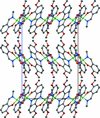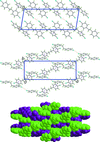issue contents
May 2019 issue

Cover illustration: A new trinuclear NiII complex, tris(![[mu]](/logos/entities/mu_rmgif.gif) 2-2-methoxy-6-{[(2-sulfidoethyl)imino]methyl}phenolato)trinickel(II) dimethylformamide monosolvate, in which each NiII ion is coordinated by two S, one N and one O atom in a slightly distorted square-planar coordination has been characterized by X-ray diffraction. The complex has a bowl shape and crystallizes with one molecule of dimethylformamide in the asymmetric unit. The crystal packing features C-H
2-2-methoxy-6-{[(2-sulfidoethyl)imino]methyl}phenolato)trinickel(II) dimethylformamide monosolvate, in which each NiII ion is coordinated by two S, one N and one O atom in a slightly distorted square-planar coordination has been characterized by X-ray diffraction. The complex has a bowl shape and crystallizes with one molecule of dimethylformamide in the asymmetric unit. The crystal packing features C-H O hydrogen bonding and C-H
O hydrogen bonding and C-H
![[pi]](/logos/entities/pi_rmgif.gif) interactions, a short C-H
interactions, a short C-H Ni contact as well as
Ni contact as well as ![[pi]](/logos/entities/pi_rmgif.gif) -
-![[pi]](/logos/entities/pi_rmgif.gif) interactions. The complex has antibacterial activity, especially against Acinetobacter baumannii. See: Rusanova, Kokozay & Pokas [Acta Cryst. (2019). E75, 616-619].
interactions. The complex has antibacterial activity, especially against Acinetobacter baumannii. See: Rusanova, Kokozay & Pokas [Acta Cryst. (2019). E75, 616-619].
research communications
















































































 journal menu
journal menu

























































